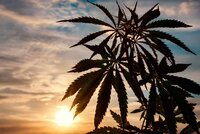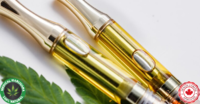- Thread starter
- #401
DrCannaCanadian
Well-Known Member
Growing cannabis can be a tricky proposition. However, there are some tried and true techniques to preventing damage to the plants from overheating.
Are your plants looking a little worse for wear? Despite following an accurate feeding, watering, and light schedule, you are frustrated to discover discoloured and deformed leaves on your cannabis plants. Don’t worry, you’re probably doing everything else correctly, it could just be the signs of heat stress.
Cannabis is a hardy and resilient plant, and many original landrace varieties adapted to survive in harsh regions such as the Hindu Kush mountain range and the tundras of Central and Northern Asia. Despite the resilience of this plant species, it can only deal with a certain amount of heat before its physiological systems can’t take it anymore.
HOW CAN YOU IDENTIFY HEAT STRESS?
One of the telltale signs of heat stress is when the tips of fan leaves begin to curl upward. They’ll also exhibit a generally dry and withered look. This factor indicates that heat is the most likely culprit, removing the possibility of most nutritional deficiencies. As well as looking generally unwell, leaves will develop large brown spots or blotches that manifest in irregular shapes, primarily along the edges of the fingers of fan leaves. These unsightly scars are usually accompanied by yellow patches of discolouration. These symptoms mainly affect leaves located near the top of the canopy and around the perimeter of the plant—areas in the direct line of fire.
If you detect this set of symptoms in the vegetative phase, you can be sure that heat stress is at the bottom of it. Indoors, this could be caused by allowing the tops of your plants to grow too close to a powerful light source. Outdoors, it could be the result of a particularly brutal heatwave or an extremely hot and dry climate.
Heat stress manifests differently during the flowering phase. Sometimes, much to the shock of many growers, new buds can start to erupt out of the tops of older ones. This can cause what is known as a foxtail, a pillar of small buds and sugar leaves. This is a survival mechanism initiated by the plant as it attempts to form new buds capable of reproducing and generating seeds.
Below, we’ll cover indoor and outdoor methods to prevent and treat heat stress.
DEALING WITH HEAT STRESS INDOORS
Heat stress can affect an indoor grow in multiple ways. For one, growers who live in hot climates may find it hard to regulate indoor temps during the dog days of summer.
Regardless of climate, grow tents can become very warm if certain measures aren’t put in place. The heat generated from different light sources can pound down upon leaves and subject them to significant stress. A lack of adequate fans and an exhaust system prevents convection currents that would otherwise cool down the interior of the tent. Here are some tips to help you avoid heat stress indoors.
PLACE FANS IN THE GROW SPACE
This is a simple and cheap solution to start cooling down your growing environment. Fans disrupt still, hot air and will effectively create a convection current that will help to cool things down. The wind generated by fans will also gently stress your plants into developing thicker and stronger stems.
USE AIR CONDITIONING
This might seem obvious, but it’s definitely a viable solution. Indoor growers have the advantage of taking complete control over the microclimate of the grow tent, provided they have access to the right equipment. This is a fairly expensive option, but can be a real life-saver if you live in areas such as Spain or the southern United States. Place an air conditioning unit in your grow tent to keep cool air circulating.
If your plants begin to exhibit signs of heat stress, consider how close they are to the light source. If only the top fan leaves are showing symptoms, then readjust the position of your lights so that they hang further away.
If changing the position makes no difference, then you might need to change the type of light you are using. Most lights put out a fair amount of heat, and if you’re growing in a confined space in a warm climate, things are going to heat up quickly. LEDs are a good option for growers dealing with these conditions. They put out a lot less heat than HID light sources; plus, they are often much cheaper to run.
INSTALL AN EXHAUST SYSTEM
An exhaust system is like a reverse fan. It works by sucking stale and hot air out of the grow space. If you have fans running at the same time, these will serve to replace old air with fresh and cool air. If you’re running a deaerator, it’s advised to fit it with a carbon filter that will remove any suspicious scents from blowing out into the surrounding area.
USE SUPPLEMENTS TO TREAT DAMAGED PLANTS
Some growers find success using supplements to treat the symptoms of heat stress. These may be effective, but will only work long-term if the environment is cooled down using the techniques mentioned above.
Seaweed or kelp extracts work well to remedy some of the effects of heat stress. They are loaded with minerals and nutrients that make plants more resistant to high temperatures. Then there's silicon, a compound that increases the resilience of cell walls, makes plants more resistant to heat and cold stress, and helps them absorb key nutrients such as zinc, copper, and phosphorous more easily.
HOW TO PROTECT AGAINST HEAT STRESS OUTDOORS
Outdoor growing is more difficult to control than the alternative. Crops are subject to the whims of the elements, as well as countless forms of pests and infections that can damage vitality and yield. Heat stress is no exception. Indoor growers have the advantage of full climate control, whereas outdoor growers have to deal with heatwaves, monsoons, and everything in between.
Heat stress is a prominent threat to those growing in warmer regions closer to the equator. Although increased levels of sunlight can be advantageous, too much can lead to heat stress symptoms. Here are some tips on how to protect your outdoor crop.
TIME YOUR WATERING WELL
During a heatwave, try to water plants either in the mornings or evenings when the temperature is less intense. Watering your plants in the middle of the day might seem like a good way to cool them down, but it can actually be harmful. Water droplets can magnify sunlight and cause increased heat to be directed toward plant tissue.
POTS ARE MORE PORTABLE
If you’re growing outside in a warm climate, it’s a good idea to grow in large containers or pots as opposed to directly in the ground. This makes your plants portable and gives you the option of physically relocating them to a sheltered spot if the sun gets too intense.
Keeping your plants under a shelter all day long will inhibit photosynthesis and have a detrimental effect overall. However, making a temporary shelter using cloth or a tarpaulin can help to protect your crop during the peak heat of the day. Erect the shelter during the hottest hours, and let your plants bask in sunshine before the heat sets in and after it tapers off.
OUTDOOR PLANTS CAN BENEFIT FROM SUPPLEMENTS, TOO
Seaweed or kelp extract can help increase plant resilience both indoors and outdoors. Use the formula according to the manufacturer's instructions and give your plants some extra protection using these nutrient-rich substances.
START WITH A HEAT-RESISTANT STRAIN
There are thousands of cannabis strains available on the market, and each one has been selectively bred over time to display specific desirable traits. Some breeders have managed to create cultivars that are particularly resilient to high temperatures. You can significantly reduce the risk of heat stress by starting with one of these varieties. Here are three heat-resistant strains we recommend.
FRUIT SPIRIT
Fruit Spirit is a hardcore strain that laughs in the face of high temperatures (within reason). This beast is the offspring of legendary parent strains White Widow and Blueberry. She features a closely balanced genetic makeup of 60% sativa genetics and 40% indica. Fuelled by 18% THC and a medium CBD level, she offers a high that relaxes the body and invigorates the mind. Her name is a tribute to the sugary and fruity tastes of her flowers, which dance across the tongue when smoked.
Fruit Spirit grows well in both indoor and outdoor environments. Indoor plants reach a height of 80–120cm, feature a flowering time of 8–10 weeks, and yield up to 425g/m². A single plant grown outdoors can reach up to 220cm in height and produce a harvest of up to 525g.
Amnesia Haze is a tall sativa-dominant strain that thrives in warmer temperatures. Her large and tall flowers produce a massive THC level of 22% and a medium level of CBD. The high is electrifying, stimulating, and ideal for daytime use to boost focus and motivation. This cerebral effect is augmented by notes of earth and citrus.
Amnesia Haze is a highly productive variety that will reward those growing in sultry locations. Indoor plants reach a height of 140cm, have a flowering time of 9–11 weeks, and produce a large harvest of up to 650g/m². Plants grown outdoors under the beating sun reach a towering height of 210cm. Here, a single specimen provides a massive bounty of up to 700g, ready to harvest in late October.
Royal Moby is a stunning specimen that boasts flowers and sugar leaves coated with trichomes. This sativa-dominant lady is the lovechild of Haze and White Widow, and oozes resin loaded with a THC concentration of 21%. This hardy variety can handle both hot and cold climates, and will feel right at home in a warm grow tent or sun-exposed garden.
Royal Moby isn’t fussy about her growing environment. Indoors, she’ll reach a height of 80–140cm and produce up to 600g/m². A plant grown outdoors will surge to a massive height of 2–3m and produce a rewarding harvest of 700g.
















